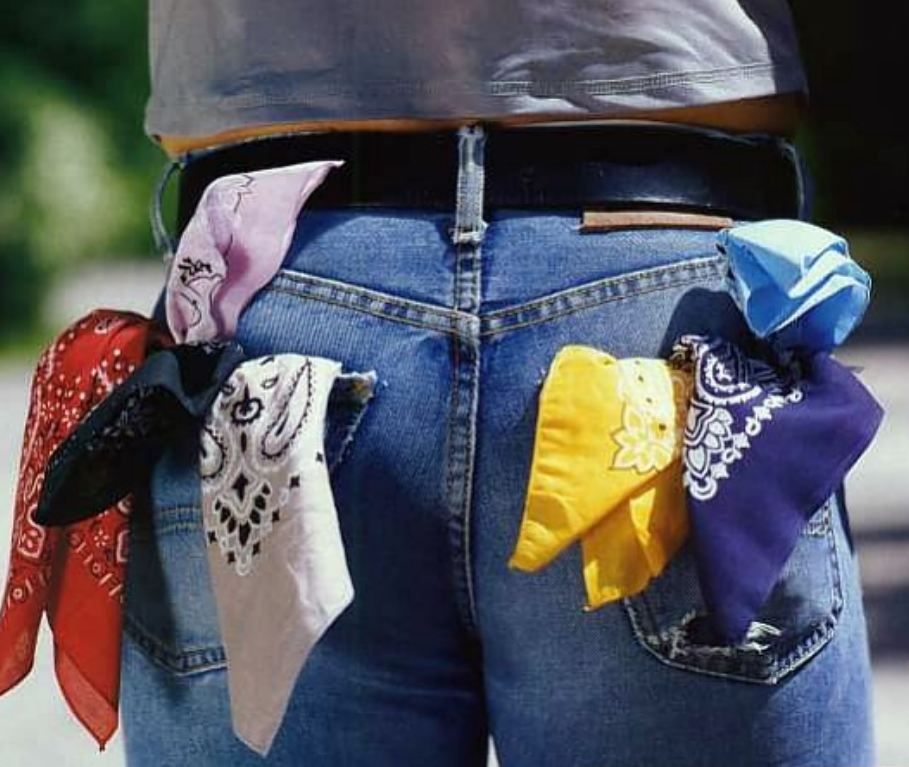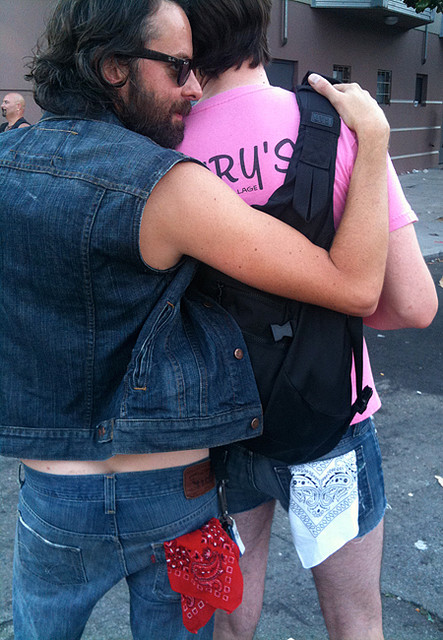Handkerchief code on:
[Wikipedia]
[Google]
[Amazon]
 The handkerchief code (also known as the hanky code, the bandana code, and flagging) is a system of color-coded cloth handkerchief or bandanas for non-verbally communicating one's interests in sexual activities and
The handkerchief code (also known as the hanky code, the bandana code, and flagging) is a system of color-coded cloth handkerchief or bandanas for non-verbally communicating one's interests in sexual activities and
 The wearing of colored bandanas around the neck as a practical accessory was common in the mid- and late-nineteenth century among
The wearing of colored bandanas around the neck as a practical accessory was common in the mid- and late-nineteenth century among 
 The handkerchief code (also known as the hanky code, the bandana code, and flagging) is a system of color-coded cloth handkerchief or bandanas for non-verbally communicating one's interests in sexual activities and
The handkerchief code (also known as the hanky code, the bandana code, and flagging) is a system of color-coded cloth handkerchief or bandanas for non-verbally communicating one's interests in sexual activities and fetishes
A fetish (derived from the French , which comes from the Portuguese , and this in turn from Latin , 'artificial' and , 'to make') is an object believed to have supernatural powers, or in particular, a human-made object that has power over o ...
. The color of the handkerchief identifies a particular activity, and the pocket it is worn in (left or right) identifies the wearer's preferred role in that activity. Wearing a handkerchief on the left side of the body typically indicates one is a "top" (considered ''active'' in the act/fetish indicated by the color of the handkerchief), while wearing it on the right side of the body would indicate one is a "bottom" (considered ''passive'' in it). For example, a dark blue handkerchief indicates an interest in anal sex, and wearing it in the left pocket indicates a preference for being the insertive partner. The code was most widely used in the 1970s in the United States, Canada, Australia, and Europe, by gay and bisexual men seeking casual sex, or BDSM
BDSM is a variety of often erotic practices or roleplaying involving bondage, discipline, dominance and submission, sadomasochism, and other related interpersonal dynamics. Given the wide range of practices, some of which may be engaged ...
practitioners.
Origin
 The wearing of colored bandanas around the neck as a practical accessory was common in the mid- and late-nineteenth century among
The wearing of colored bandanas around the neck as a practical accessory was common in the mid- and late-nineteenth century among cowboy
A cowboy is an animal herder who tends cattle on ranches in North America, traditionally on horseback, and often performs a multitude of other ranch-related tasks. The historic American cowboy of the late 19th century arose from the '' vaqu ...
s, steam railroad engineers, and miners in the Western United States
The Western United States (also called the American West, the Far West, and the West) is the region comprising the westernmost states of the United States. As American settlement in the U.S. expanded westward, the meaning of the term ''the We ...
. It is thought that the wearing of bandanas by gay men originated in San Francisco
San Francisco (; Spanish for " Saint Francis"), officially the City and County of San Francisco, is the commercial, financial, and cultural center of Northern California. The city proper is the fourth most populous in California and 17t ...
after the Gold Rush
A gold rush or gold fever is a discovery of gold—sometimes accompanied by other precious metals and rare-earth minerals—that brings an onrush of miners seeking their fortune. Major gold rushes took place in the 19th century in Australia, New ...
, when, because of a shortage of women, men dancing with each other in square dance
A square dance is a dance for four couples, or eight dancers in total, arranged in a square, with one couple on each side, facing the middle of the square. Square dances contain elements from numerous traditional dances and were first documente ...
s developed a code wherein the man wearing the blue bandana took the male part in the square dance, and the man wearing the red bandana took the female part (these bandanas were usually worn around the arm or hanging from the belt or in the back pocket of one's jeans
Jeans are a type of pants or trousers made from denim or dungaree cloth. Often the term "jeans" refers to a particular style of trousers, called "blue jeans", with copper-riveted pockets which were invented by Jacob W. Davis in 1871 and pa ...
).
The modern hanky code is often reported to have started in New York City around 1970, when a journalist for the '' Village Voice'' joked that instead of simply wearing a set of keys on one side or the other (then a common code to indicate whether someone was a "top" or a "bottom"), it would be more efficient to subtly announce their particular sexual focus by wearing different colored handkerchiefs. Other sources attribute the expansion of the original red–blue system into today's code to marketing efforts around 1971 by The Trading Post, a San Francisco department store
A department store is a retail establishment offering a wide range of consumer goods in different areas of the store, each area ("department") specializing in a product category. In modern major cities, the department store made a dramatic appe ...
for erotic merchandise, promoting handkerchiefs by printing cards listing the meanings of various colors.
Alan Selby, founder of Mr. S Leather in San Francisco, claimed that he created the first hanky code with his business partners at Leather 'n' Things in 1972, when their bandana supplier inadvertently doubled their order and the expanded code would help them sell the extra colors they had received.
Around 1980, '' Bob Damron's Address Book'' published a yearly chart for the meaning of each colored handkerchief.

Examples
There was no single authoritative standard for the code. This table is drawn fromLarry Townsend
Larry Townsend (27 October 1930 – 29 July 2008) was the American author of dozens of books including ''Run, Little Leather Boy'' (1970) and ''The Leatherman's Handbook'' (1972), published by pioneer erotic presses such as Greenleaf Classics an ...
's ''The Leatherman's Handbook II'' (the 1983 second edition; the 1972 first edition did not include this list) and is generally considered authoritative. Implicit in this list is the concept of left/right polarity, left as usual indicating the top, dominant, or active partner; right the bottom, submissive, or passive partner. Townsend noted that discussion with a prospective partner was still important because, people may wear a given color "only because the idea of the hankie turns them on" or "may not even know what it means".
The longer lists found on the web are more elaborate and the many color codes in them are less often used in practice, although some of these colors are offered for sale at LGBT stores along with free cards listing their meanings.
Modern use
The hanky code has recently undergone a revival and while the use of handkerchiefs may not be as prevalent, the hanky colours are a common consideration in the choice of leather and fetish gear colour. It should not, however, always be assumed this is the case and is best used as a conversation starter rather than a certain indication of sexual preferences. The hanky code was a semiotic system of sexual advertising popular among the gay leather community of the United States and cruising scene more broadly.Social networking service
A social networking service or SNS (sometimes called a social networking site) is an online platform which people use to build social networks or social relationships with other people who share similar personal or career content, interests, ac ...
s may have replaced the use of hankies in cruising areas by digitizing the process. By using online platforms, men who have sex with men (MSM) can eliminate harassment and violence that they may face in public. Social networking services for MSM also allow for sub-groups, and for people to list fetishes, and what they are looking for, which is where the replacement of the need for hankies may have come from.
In popular culture
* In the film '' Cruising'', Detective Steve Burns (Al Pacino
Alfredo James Pacino (; ; born April 25, 1940) is an American actor. Considered one of the most influential actors of the 20th century, he has received numerous accolades: including an Academy Award, two Tony Awards, and two Primetime Emmy ...
) goes into a store and has the handkerchief code explained to him by a hanky salesman ( Powers Boothe).
* In the early 1980s, Judas Priest frontman Rob Halford
Robert John Arthur Halford (born 25 August 1951) is an English heavy metal singer. He is the lead vocalist of Judas Priest, which was formed in 1969 and has received accolades such as the 2010 Grammy Award for Best Metal Performance. He has ...
made the handkerchief code part of his stage costume. In the music video for "Heading Out to the Highway
"Heading Out to the Highway" is a song by English heavy metal band Judas Priest from their 1981 album '' Point of Entry''. It was released as a single later that year, and was the band's first single to reach the US Mainstream Rock chart, peak ...
", Halford can be seen wearing a red handkerchief in his left pocket.
See also
* HomosocializationReferences
Further reading
* {{LGBT slang BDSM terminology Color codes Encodings Leather subculture LGBT symbols LGBT terminology Male homosexuality Semiotics